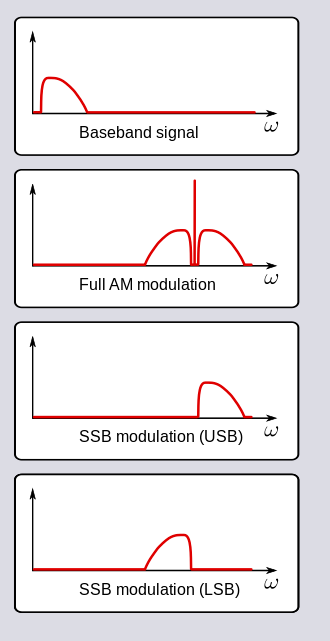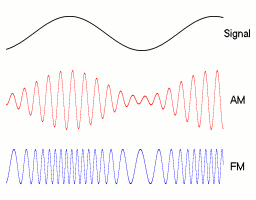Amateur radio operator here, I see some things in this thread that are kinda correct in this case but not technically accurate, and I'd like to provide the actual details:
I see folks asserting that "AM goes farther than FM." This is only accidentally true in this case. The stations that your car radio's AM setting can pick up are transmitting in the Medium Frequency (MF) spectrum, around 500 to 1600 kHz. The wavelengths here are around 200 meters. Radio waves with these wavelengths can refract around the Earth's surface, or at night bounce off the higher layers of the ionosphere, to be heard hundreds or thousands of miles away (respectively).
By contrast, commercial FM broadcasts are done right in the middle of the VHF band, from 88 to 107 MHz in the US. These waves don't refract off the ground or sky, and only travel in straight lines, so you have to be fairly close (within 75 miles depending on the height of the antenna) to hear them.
The terms "AM" and "FM" refer to how the audio signal is encoded on the radio wave; the short answer is Amplitude Modulation gets brighter/dimmer, FM gets redder/bluer. This is very little to do with how far the signal will travel, though it can have ramifications for how easy it is to hear near the edge of range and rising above the noise floor, etc. Both modes are relatively inefficient with power and bandwidth for different reasons; AM is primitive and FM is fancy.
AM radio is kept deliberately simple. Like, pre WWII simple. You can improvise an AM radio receiver with stuff you have lying around your house. I've seen a diode made out of a rusty razor blade and a pencil. It doesn't have the best audio quality, it's a bit of a waste of bandwidth compared to something like Single Sideband (which is cool but beyond the scope of this comment. Ask me about SSB if you want to hear about some cool radio shit) but it's easy to find or make a working AM radio. There's nothing that says you have to use AM on lower frequencies; aviation communication radios are AM (because we started using radios in planes before FM was invented) and they're in the VHF spectrum just above the FM broadcast band and just below the amateur 2 meter band.
FM is fancier, it chews up even more bandwidth depending on the exact implementation and is less power efficient, but it offers the potential for less natural interference, better audio quality, and they even broadcast it in stereo. There's just so narrow in terms of bandwidth you can make FM, which is why you don't find it in use below 10 meters (about 28 MHz); there's just no room for it. FM radios are more complicated, compared to a smart phone or PC they're pretty basic but you're not as likely to successfully improvise one out of shit you find in a tool shed.
In terms of sources for emergency information? I want both and more. AM broadcasting is the very definition of "good old" and relatively few stations can reach a national audience fairly easily, though FM stations typically take a LOT less power to run so I think they'd plausibly be up and running in a partial grid failure, and they're more localized. So for a national emergency I might tune into AM, for a local emergency I'm going to tune into my town's FM station that is 6 miles from my house.
I would also want a WX band radio. For those who aren't familiar, the National Weather Service operates a network of transmitters that broadcast continuous weather information on one of a dozen channels in the 160 MHz range, narrow band FM. If you've had a "weather radio" that's what that is. I know of very few car stereos that are equipped to receive WX band broadcasts and now that I think about it I can't imagine why it hasn't been mandatory for decades.

